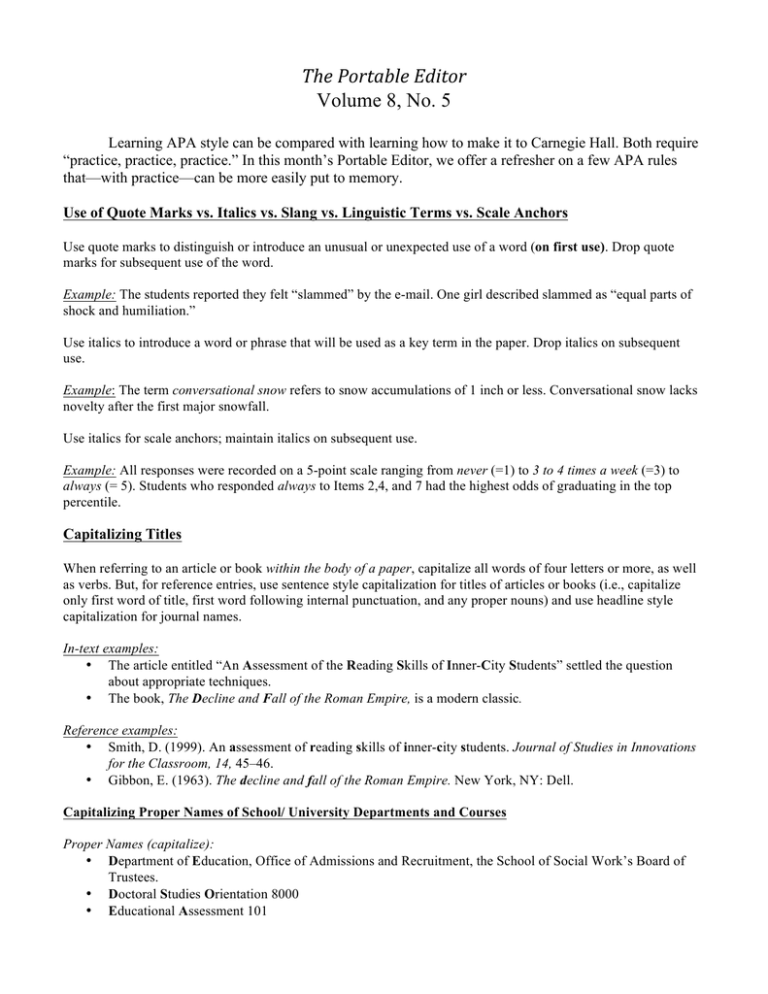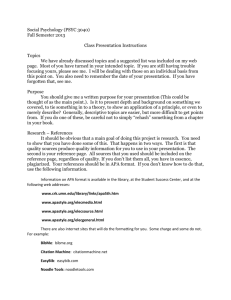The Portable Editor Volume 8, No. 5
advertisement

ThePortableEditor Volume 8, No. 5 Learning APA style can be compared with learning how to make it to Carnegie Hall. Both require “practice, practice, practice.” In this month’s Portable Editor, we offer a refresher on a few APA rules that—with practice—can be more easily put to memory. Use of Quote Marks vs. Italics vs. Slang vs. Linguistic Terms vs. Scale Anchors Use quote marks to distinguish or introduce an unusual or unexpected use of a word (on first use). Drop quote marks for subsequent use of the word. Example: The students reported they felt “slammed” by the e-mail. One girl described slammed as “equal parts of shock and humiliation.” Use italics to introduce a word or phrase that will be used as a key term in the paper. Drop italics on subsequent use. Example: The term conversational snow refers to snow accumulations of 1 inch or less. Conversational snow lacks novelty after the first major snowfall. Use italics for scale anchors; maintain italics on subsequent use. Example: All responses were recorded on a 5-point scale ranging from never (=1) to 3 to 4 times a week (=3) to always (= 5). Students who responded always to Items 2,4, and 7 had the highest odds of graduating in the top percentile. Capitalizing Titles When referring to an article or book within the body of a paper, capitalize all words of four letters or more, as well as verbs. But, for reference entries, use sentence style capitalization for titles of articles or books (i.e., capitalize only first word of title, first word following internal punctuation, and any proper nouns) and use headline style capitalization for journal names. In-text examples: • The article entitled “An Assessment of the Reading Skills of Inner-City Students” settled the question about appropriate techniques. • The book, The Decline and Fall of the Roman Empire, is a modern classic. Reference examples: • Smith, D. (1999). An assessment of reading skills of inner-city students. Journal of Studies in Innovations for the Classroom, 14, 45–46. • Gibbon, E. (1963). The decline and fall of the Roman Empire. New York, NY: Dell. Capitalizing Proper Names of School/ University Departments and Courses Proper Names (capitalize): • Department of Education, Office of Admissions and Recruitment, the School of Social Work’s Board of Trustees. • Doctoral Studies Orientation 8000 • Educational Assessment 101 • The name of a test is a proper noun, so be sure to capitalize when used in a reference entry: o Purring, A. (2012). Charisma and Tenacity Survey [Measurement instrument]. Retrieved from http://www.apa.org/tests/measures/instruments/surveys /charisma.html Informal Names (lowercase): • an education department • a doctoral orientation • an educational assessment course • a board of trustees What Not to Capitalize All nouns are not proper nouns. Writers tend to overuse capitalization, especially with the following types of terms. Note that proper nouns (e.g., a person’s name) within these terms are capitalized. Model five-factor personality model, associative learning model Theory Bandura’s social learning theory, psychoanalytic theory Therapy or technique client-centered therapy, cognitive-behavior therapy Concept object permanence, confirmation bias, correlation Disease/disorder major depressive disorder, Alzheimer’s disease, obsessive-compulsive disorder, Crohn’s disease, depression Hypothesis null hypothesis, the second hypothesis (but Hypothesis 2…) Condition in an experiment control group, experimental group, treatment group, no-information group Statistical procedure or test analysis of variance, t test, chi-square test Academic subject/discipline social work, psychology, a master’s in public health Adapted from the APA Style Blog: http://blog.apastyle.org/apastyle/2012/02/do-i-capitalize-thisword.html Citing a Sakai Course The format really depends on the intended audience. When writing a paper for a class whose members have access to the Sakai site, use the following format: Reference example: Brief History of Oppression and Resistance (n.d.). Marginalization. Retrieved from https://sakai.unc.edu/portal/site/6fcf56f7-818b-42bc-8a65-5235f84b83cb In-text citation example: (“Brief History,” n.d.). The title of the course is used because the website doesn’t indicate authorship. The in-text citation also shortens the title to as few words as necessary for the reader to locate the entry in the reference list. For a paper intended for a non-School of Social Work audience (i.e., no access to the Sakai site), use the following, which bends the APA rules a bit to include the School’s info, making it a retrievable source: Reference example: Brief History of Oppression and Resistance (n.d.). Marginalization [Online class module]. School of Social Work, University of North Carolina at Chapel Hill. In-text citation example: (“Brief History,” n.d.) Need one-on-one writing support? Please e-mail to schedule an appointment soswwritingsupport@gmail.com





